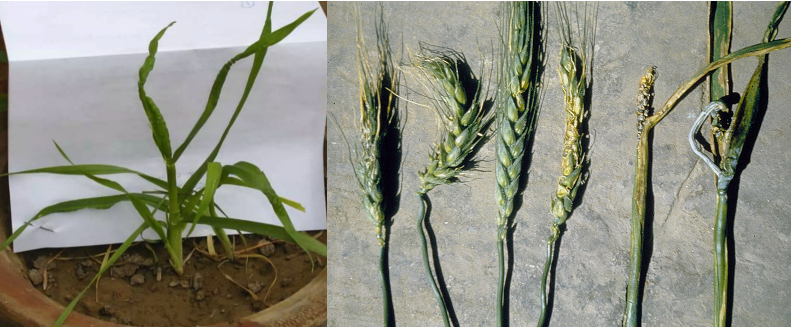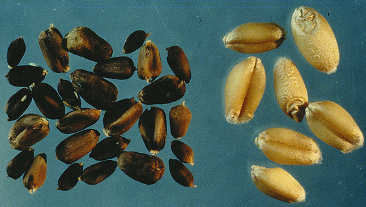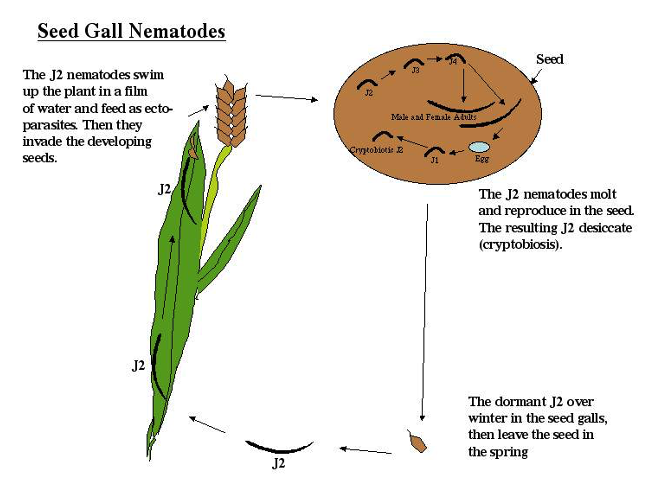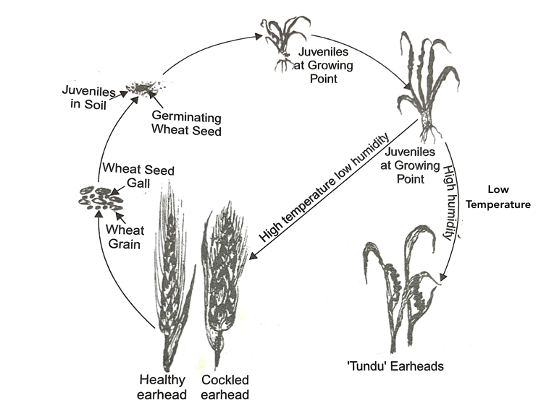🪱 Seedgall Nematodes
Species, Biology, Symptoms, Integrated Management
Which of the following is correct regarding seed gall nematodes?
- First plant parasitic nematode reported by
Needhamin 1743. - Later, Steinbuch (1799) described it as Vibrio tritici. The present name Angunia tritici was given by Filipjev in 1936.
- Angunia is derived from Latin: anguinus means snake-like specific name after host Triticum astivum.
- In India, Milne reported it for the first time from Punjab in 1919.
- In India, it is widespread in the northern wheat growing states of Bihar, Delhi, Haryana, Himachal Pradesh, Madhya Pradesh, Punjab, Rajasthan and Uttar Pradesh.
- During 1996 to 1998, the disease caused by this nematode appeared in an epidemic form in Bihar and Madhya Pradesh, where farmers burnt the standing crop.
- Wheat is the main host of the nematode.
Biology
- Seedgalls mixed with seed get introduced into the soil at the time of sowing. Each seedgall may contain 3000 to 12000 second-stage juveniles (J2) in a quiescent phase. In Soil they absorb moisture and become soft and J2 becomes active.
- At the time of floral initiation, the second-stage juveniles enter inside the floral primordia and become endoparasites.
- It first feeds as ecto-parasitically & after three moults it becomes endoparasitic.
- After mating, females start laying eggs inside the gall which replaces the developing seed.
- At harvest, seedgalls are also collected along with healthy seeds. When this contaminated seed is used for sowing again the next year, the life cycle repeated.
- The quiescent juveniles can remain viable inside the galls for as many as 32 years, if they do not contact moisture.
- Some species of Anguina produces galls in leaf surface for e.g., A. tumafaciens on Cynodon transvalense.
Earcockle Disease

- The nematode alone causes earcockle disease of wheat.
- This disease is locally known as ‘Sehu’ (सेहु), ‘Gegla’ or ‘Mamni’.
- The infected plants are generally stunted and grow prostrate with increased tillering.
- Plant shows profuse tillering and infested plant produce earheads almost 30-40 days before healthy plants.
- The affected earheads are generally shorter and broader.
- The most important symptom of this nematode is the conversion of grains in to cockles or galls.

- The galls or cockles are smaller, dark brown or black, and irregular in shape compared to healthy seeds.

Tundu Disease

- Angunia tritici is often associated with bacterium Clavibacter tritici (Corynebacterium tritici) in causing another disease known as
Yellow Ear Rot. - This disease is locally knonw as
Tundu. - Angunia tritici acts as a vector in this disease complex.
- The initial symptoms like basal swelling, crinkling, curling and twisting of leaves are similar to earcockle disease. Earhead टुंडा यानी टेढ़ा हो जाता है।
- In later stage, due high humidity 🌧️ and low temperature 🥶, the bacterium multiplies very rapidly and appears in the form of yellow slimy ooze on the surface of leaves and stem.
- Tundu disease is more damaging than earcockle.
Management
- Presence of galls in the seed material is the source of inoculm both for the earcockle and tundu dieases.
- It is possible to eradicate both the dieases if gall-free certified seed is used for sowing.
- However, galls can be separated from contaminated seed material by the following methods:
- Dry cleaning/Winnowing or Fanning
- Salt floatation: Use of 20 % salt (brine) solution is used for washing of seeds. The galls will float on the surface and can be skimmed off. It is very effective control method.
- Hot water treatment: 54 °C for 10 minutes.
- Crop rotation also useful method to escape infestation of nematode.
- No resistant variety of wheat is found against this nematode.
References
- Dropkin, V.H. 1980. Introduction to plant nematology. John Wiley and sons, INC. New York.
- Singh, R.S and Sitaramaiah, K. 1994. Plant pathogens. The plant parasitic nematodes. Oxford & IBH Pub. Co. Pvt. Ltd. New Delhi.
- Parvata Reddy, P. 1983. Plant nematology. Agricole Pub. Co., New Delhi.
- Southey, J. F. Laboratory methods for work with plant and soil nematodes Tech.
- Bull. Min. Agric. Fish. Food. Her Majesty’s Stationary Office, London.
- Walia, R. K and Bajaj, H. K (2014). Textbook of Introductory Plant Nematology. Directorate of Knowledge Management in Agriculture, ICAR, New Delhi.
- Kumar, V., Khan, M.R. & Walia, R.K. Crop Loss Estimations due to Plant-Parasitic Nematodes in Major Crops in India. Natl. Acad. Sci. Lett. 43, 409–412 (2020). https://doi.org/10.1007/s40009-020-00895-2
- Figure 1: Source: A: Maggenti, 1981, B-E: Franklin, 1973
Which of the following is correct regarding seed gall nematodes?
- First plant parasitic nematode reported by
Needhamin 1743. - Later, Steinbuch (1799) described it as Vibrio tritici. The present name Angunia tritici was given by Filipjev in 1936.
- Angunia is derived from Latin: anguinus means snake-like specific name after host Triticum astivum.
- In India, Milne reported it for the first time from Punjab in 1919.
- In India, it is widespread in the northern wheat growing states of Bihar, Delhi, Haryana, Himachal Pradesh, Madhya Pradesh, Punjab, Rajasthan and Uttar Pradesh.
- During 1996 to 1998, the disease caused by this nematode appeared in an epidemic form in Bihar and Madhya Pradesh, where farmers burnt the standing crop.
- Wheat is the main host of the nematode.
Biology
- Seedgalls mixed …
Become Successful With AgriDots
Learn the essential skills for getting a seat in the Exam with
🦄 You are a pro member!
Only use this page if purchasing a gift or enterprise account
Plan
Rs
- Unlimited access to PRO courses
- Quizzes with hand-picked meme prizes
- Invite to private Discord chat
- Free Sticker emailed
Lifetime
Rs
1,499
once
- All PRO-tier benefits
- Single payment, lifetime access
- 4,200 bonus xp points
- Next Level
T-shirt shipped worldwide

Yo! You just found a 20% discount using 👉 EASTEREGG

High-quality fitted cotton shirt produced by Next Level Apparel